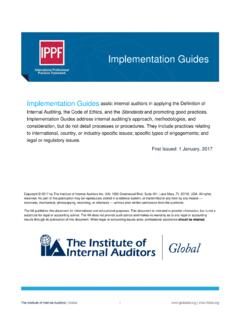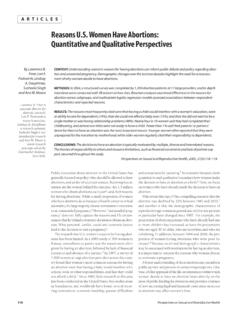Transcription of Legal Brief on International Law and Rescue at Sea
1 Legal Brief on International Law and Rescue at Sea For further information on International law relating to Rescue at sea, please see UNHCR/IMO Informational Pamphlet: Rescue at Sea included in this conference binder. 1 Legal Framework United Nations Convention on the Law of the Sea, 1982, Article 98. International Convention on Maritime Search and Rescue , 1979, as amended, International Convention for the Safety of Life at Sea, 1974, as amended, chapter V, regulation33. Convention on Facilitation of International Maritime Traffic, 1965, in particular Section , Standards International Convention on Salvage, 1983, Article 11.
2 Resolution (18) on Enhancement of safety of life at sea by the prevention and suppression of unsafe practices associated with alien smuggling by ships Resolution (20) on Guidelines on the allocation of responsibilities to seek the successful resolution of stowaway cases Resolution (20) on Combating unsafe practices associated with the trafficking or transport of migrants by sea IMO Global SAR Plan. and addenda addresses (the Admiralty List of Radio Signals, Volume 5, is a practical alternative). United Nations Convention relating to the Status of Refugees, 1951 and its 1967.
3 Protocol UN Convention against Transnational Organized Crime, 2000 and its Protocols, Protocol against the smuggling of migrants by land, sea and air; and Protocol to Prevent, Suppress and Punish Trafficking in Persons, Especially Women and Children. on Interim measures for combating unsafe practices associated with the trafficking or transport of immigrants by sea 2 Obligation to provide assistance to persons in distress at sea, Responsibility of the shipmaster (United Nations Convention on the Law of the Sea, 1982, International Convention for the Safety of Life at Sea, 1974, as amended).
4 Shipmasters have certain duties that must be carried out in order to provide for safety of life at sea, preserve the integrity of global SAR services of which they are part, and to comply with humanitarian and Legal obligations. In order to more effectively contribute to safety of life at sea, ships are urged to participate in ship reporting systems established for the purpose of facilitating SAR. operations. 3 Obligation to establish search and Rescue centres (Responsibilities and preparedness). (The International Convention for the safety of life at sea, Chapter 5, Reg 7, The International Convention on maritime search and Rescue , Chapter , as amended).
5 Governments should ensure that their respective Rescue co-ordination centres (RCCs). and other national authorities concerned have sufficient guidance and authority to fulfil their duties Governments should ensure that their RCCs and Rescue units are operating in accordance with the standards and procedures in the IAMSAR Manual and that all ships operating under their flag have on board Volume III of the IAMSAR Manual. A ship should not be subject to undue delay, financial burden or other related difficulties after assisting persons at sea; therefore coastal States should relieve the ship as soon as practicable.
6 Normally, any SAR co-ordination that takes place between an assisting ship and any coastal State(s) should be handled via the responsible RCC. Each RCC should have effective plans of operation and arrangements (interagency or International plans and agreements if appropriate) in place for responding to all types of SAR situations. 4 Humanitarian obligations: State obligations under the International law IMO Resolution A 920 (22): safety measures and procedures for the treatment of persons rescued at sea The objectives are to help ensure that: .1 survivors of distress incidents are provided assistance regardless of nationality or status or the circumstances in which they are found.
7 2 ships, which have retrieved persons in distress at sea, are able to deliver the survivors to a place of safety; and .3 survivors, regardless of nationality or status, including undocumented migrants, asylum seekers and refugees, and stowaways, are treated, while on board, in the manner prescribed in the relevant IMO instruments and in accordance with relevant International agreements and long-standing humanitarian maritime traditions. 5 2004 Amendments to SOLAS and SAR. th (78 session of MSC). chapter V of the International Convention for the Safety of Life at Sea (SOLAS).
8 Chapters 2, 3 and 4 of the Annex to the International Convention on Maritime Search and Rescue Convention (SAR Convention). Purpose of these amendments: is to help ensure that persons in distress are assisted, while minimizing the inconvenience to assisting ships and ensuring the continued integrity of SAR services. Amendments impose upon Governments an obligation to co-ordinate and co- operate to ensure that masters of ships providing assistance by embarking persons in distress at sea are released from their obligations with minimum further deviation from the ship's intended voyage.
9 6 Place of safety A place of safety (as referred to in the Annex to the 1979 SAR Convention, paragraph ) is a location where Rescue operations are considered to terminate. It is also a place where the survivors. safety of life is no longer threatened and where their basic human needs (such as food, shelter and medical needs) can be met. Further, it is a place from which transportation arrangements can be made for the survivors. next or final destination. Governments should co-operate with each other with regard to providing suitable places of safety for survivors after considering relevant factors and risks.
10 The need to avoid disembarkation in territories where the lives and freedoms of those alleging a well-founded fear of persecution would be threatened is a consideration in the case of asylum-seekers and refugees recovered at sea.















